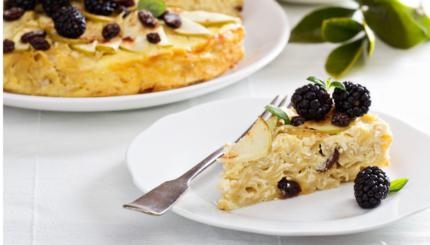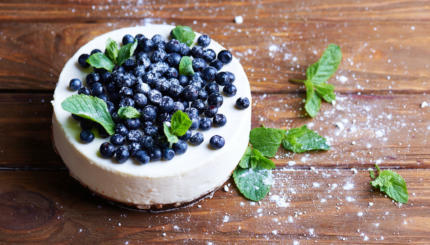“Goats are the Jews of the animal kingdom,” Aitan Mizrahi told a group at the Hazon Food Conference on Friday morning. The workshop participants, gathered in the warm, cream-scented air of a small industrial kitchen at the Isabella Freedman Jewish Retreat Center, immediately picked up on the tongue-in-cheek theme: They wander, they are intelligent, and they are stiff-necked, they said. And, Mizrahi pointed out, “They enjoy to be in a minyan and they also enjoy to go off on their own and shmooze.”
So the gentle and friendly milk-producers make a perfect fit for Freedman, an eco-conscious retreat space in the Berkshires.

During the session, Mizrahi described how the annex of the center’s staff housing where farming fellows make fermented delicacies, called the Cultural Center, turns goat milk into cheese and “goatgurt.” offering samples and sprinkling his presentation with biblical references. He and Adamah fellows Mònica Gomery and Rachel Freyja Bedick also explained how the participants could turn their own kitchens into cultural hot spots.
The first step in the process is to pasteurize the gallon or so of milk that each goat produces each day by keeping it at 180 degrees for 30 minutes. The milk is then brought to a lower temperature to start the cheese-making process.
The temperature and timing, regardless of the kind of cheese, are key. During the demonstration, Mizrahi focused on the somewhat forgiving farmer’s cheese.
To the warm milk, the cheese-niks add either vinegar or cheese culture and rennet to coagulate the liquid. In the batch for the demonstration, Mizrahi simply added one cup of white vinegar per gallon of milk. (It would take about ¼ teaspoon each of culture and rennet otherwise.) Before our eyes, the curds separated from the yellow-tinted whey. A volunteer helped to spoon the curds into butter muslin — a fine cheese cloth — and wrap them up.
The curds would then hang for a short time before it was ready to eat. Mizrahi uses different processes to produce feta, farmer’s cheese, rennet cheese and chevre.
When the curds drain and firm up, the cheese maker can add flavorings like olive oil, herbs, and salt. This is the one point where specific temperature and times take a back seat to taste and gut feeling. “I kind of bring down Bubbe,” Mizrahi said, especially when it comes to sea salt for the briny feta.
Mizrahi’s personal “culture revolution” did not start with previous generations, but with the goats themselves. As an Adamah fellow in 2004, he found himself helping manage the farm’s animal program, which at the time consisted of bees, chickens, and three milk goats. He left to work on farms else where but returned to the region in 2006. The following spring he purchased his first three goats, and soon started his own dairy.
Mizrahi tried a few farm and business models, including keeping his goats in different locations and selling legally questionable raw goat milk and yogurt. Several times, his efforts hit a brick wall. Then he had the idea to align with Freedman, and in 2009 founded a Grade A kosher goat dairy operation. He helped to raise funds to buy and install cheese-making equipment and soon Adamah Dairy was up and running.
Now the goat pen houses more than 20 does, kids, and bucks. Mizrahi always sells out of his $18-a-pound goat cheese and distributes its products to a number of area businesses, as well as supplies the retreat center and Adamah’s CSA members with cheese. It was the goat in him that kept his energy up when times got tough, Mizrahi said: “It was the stiff-neckedness.”
It doesn’t take an iron will to plough through most of Mizrahi’s recipes. The easiest to prepare at home is farmer cheese. Here’s the recipe:
Goat Milk Farmer’s Cheese
Courtesy of Aitan Mizrahi

Ingredients
1 gallon goat milk
1 cup vinegar
Equipment
Mixing bowl
Slotted spoon
Fine cheese cloth or butter muslin
Long wooden spoon and stock pot, or other hanging apparatus
Directions
1) Heat the milk to 180 degrees F (82 degrees C)
2) Turn off heat and allow to sit for a few minutes
3) Add one cup vinegar; stir
4) Milk will curdle
5) Spoon curds into cheesecloth
6) Gather the cheesecloth around the curds, then twist and tie the top. Hang in a place where the whey can drip into a container. One participant said that she uses a wooden spoon balanced across the top of the stock pot. Hang for up to 12 hours, then unwrap and enjoy.
Farmer’s cheese is great spread on bread or crackers with a fruit preserve. Use it like ricotta in lasagnas, or just drizzle olive oil and zatar over it for a middle eastern meal with pita.
kosher
Pronounced: KOH-sher, Origin: Hebrew, adhering to kashrut, the traditional Jewish dietary laws.
minyan
Pronounced: MIN-yun, meen-YAHN, Origin: Hebrew, quorum of 10 adult Jews (traditionally Jewish men) necessary for reciting many prayers.
Mizrahi
Pronounced: meez-RAH-khee, Origin: Hebrew for Eastern, used to describe Jews of Middle Eastern descent, such as Jews from Iraq and Syria.


